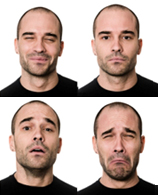 In 2001 the American Psychological Association named Paul Ekman (b. 1934) one of the most influential psychologists of the entire 20th century. In 2009 Time Magazine named him one of the 100 most influential people in the world. Lisa Barrett, professor of psychology at Northeastern University, is not impressed by the research that has made Ekman famous.
In 2001 the American Psychological Association named Paul Ekman (b. 1934) one of the most influential psychologists of the entire 20th century. In 2009 Time Magazine named him one of the 100 most influential people in the world. Lisa Barrett, professor of psychology at Northeastern University, is not impressed by the research that has made Ekman famous.
A pioneer in the study of emotions and their relation to facial expressions, Ekman created an “atlas of emotions” with more than ten thousand facial microexpressions which show up on our faces for fractions of a second as indicators of different emotions. His model afforded researchers an objective way to measure and compare human emotions.
An article published in 1969 claiming he could detect the microexpressions of emotion that appear on the face of a liar, gained him a reputation as the “best human lie detector in the world.” The CIA, the FBI, the Department of Homeland Security, the New York Police Department, and the Transportation Security Administration, were soon knocking on his door, spending millions (and even billions) of dollars to train their agents in techniques based on his theories. Ekman has published scores of influential papers and books, and his findings have been verified and expanded upon in hundreds of studies.
So why is Lisa Barrett so troubled by Ekman’s ideas? “This can’t possibly be right. It’s too cartoonish,” she said, and recently set out to challenge his research.
Finding the notion of a universal display of emotions untenable, Barrett set out to prove that people construct emotion in their own individual ways, from a diversity of sources: internal sensations, reactions to the environments they live in, ever-evolving bodies of experience and learning, and diverse cultural input.
Barrett sent a small research team to visit the isolated Himba tribe in Namibia, in southern Africa. The team, led by Maria Gendron, decided to carry out a study similar to Ekman’s original cross-cultural one, but without providing any of the special words or context-heavy stories that Ekman had used to guide his subjects’ answers. Barrett’s researchers simply handed a jumbled pile of different expressions (happy, sad, fearful, angry, disgusted, and neutral) to their subjects, and asked them to sort them into six piles. If emotional expressions are indeed universal, the researchers reasoned, then the Himba would put all low-browed, tight-lipped expressions into an anger pile, all wrinkled-nose faces into a disgust pile, and so on.
It didn’t happen that way. The Himba sorted some of the faces in ways that aligned with Ekman’s theory: smiling faces went into one pile, wide-eyed fearful faces went into another, and affectless faces went mostly into a third. But in the other three piles, the Himba mixed up angry scowls, disgusted grimaces, and sad frowns. Without any suggestive context, of the kind that Ekman had originally provided, they simply didn’t recognize the differences that leap out so naturally to Westerners.
Barrett, Gendron and two other researchers wrote a paper based on this study, which Barrett considers one of her most important to date; she submitted it to Science Magazine in December 2012, with high hopes for its publication. “What we’re trying to do is to just get people to pay attention to the fact that there’s a mountain of evidence that does not support the idea that facial expressions are universally recognized as emotional expressions.”
Writes Shannon Fischer in her article “About Face” in Boston Magazine (July 2013): “That’s the crucial point, of course, because if we acknowledge that, then the entire edifice that Paul Ekman and others have been constructing for the past half-century comes tumbling down. And all sorts of things that we take for granted today — how we understand ourselves and our relationships with others, how we practice psychology and psychiatry, how we do police work and gather intelligence — have to change.”